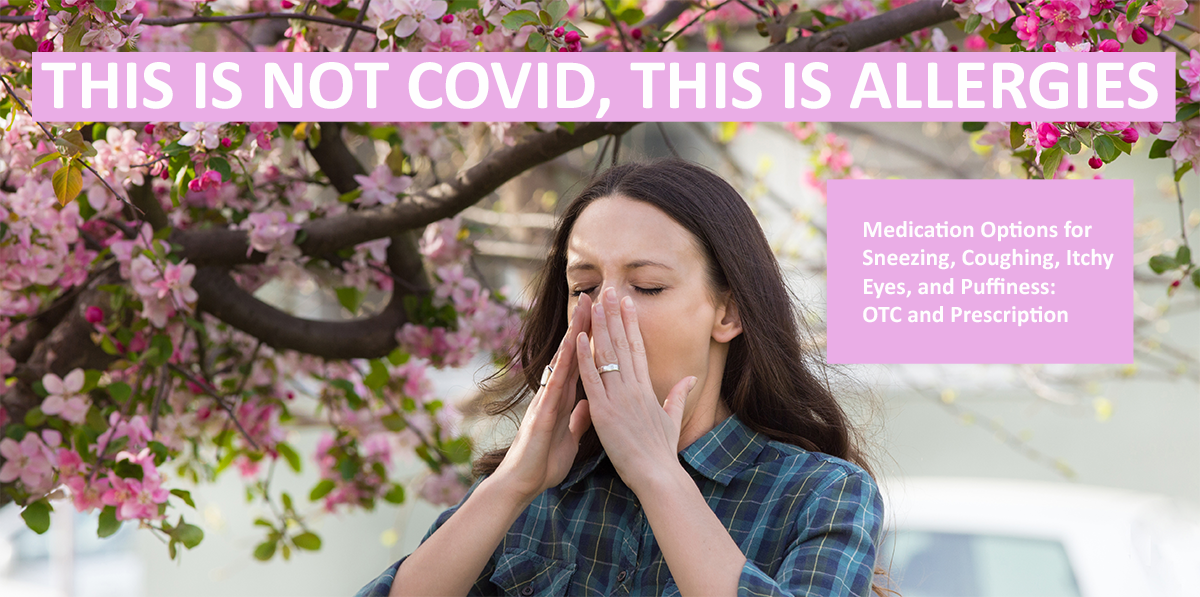It’s that time of the year! Many of us are walking around like zombies: groggy, stuffy nose, headache, sore throat, and itchy eyes. There is a lot that can be done, and much with over-the-counter (OTC) medications. You don’t have to continue in a state of pollen zombiness. The following is what I recommend for my patients.
Most of people only know about sedating (ex. Benadryl) or non-sedating antihistamines (ex.’s Claritin, Zyrtec, or Allegra). “Sedating” means they cause sleepiness, and I think most people know that Benadryl can make you sleepy. But there are now many more options now, but we’ll start with the basics.
For Mild to Moderate Nasal Congestion, Sneezing, or Sore Throat:
- Non-Sedating Antihistamines: I recommend always starting with a non-sedating antihistamine. They rarely make people sleepy, they work quickly, and they usually last all day. Examples are loratadine (Claritin), cetirizine (Zyrtec), or fexofenadine (Allegra). Zyrtec is approved for children down to 6 months of age (but talk to your doctor first when giving it to a child less than 2 years of age).
- Non-Sedating Antihistamines plus Nasal Decongestants: Two nasal decongestants, psuedoephedrine (Sudafed) and phenylephrine, can be combined with allergy medications. Pseudoephedrine works well, but it must be purchased at the pharmacy desk, because it can be abused as a stimulant or used in the production of methamphetamines. I recommend only using decongestants for short periods, such as 1 to 2 weeks at a time, and avoiding their use in the afternoon or at night, because they can cause trouble sleeping. There are many medical conditions in which decongestants should not be used, so if you have a medical condition (besides allergies) speak to your doctor before using one.
- Sedating Antihistamines (i.e. Bendaryl): I would only recommend Benadryl (diphenhydramine) if you only have trouble with allergies at bedtime. Benadryl only lasts 6 hours and makes you sleepy.
If Antihistamines Do Not Work or for Moderate to Severe Nasal Congestion and Sore Throat
- Nasal Steroid Sprays: For the majority of people, nasal steroid sprays are sufficient to manage symptoms. Examples are Flonase (fluticasone), Rhinocort (budesonide), or Nasocort (Triamcinolone). I recommend fluticasone as it is a “2nd generation” spray, so less than 1% of the medication enters your body (as opposed to 10 to 50% of the older sprays, like triamcinolone or budesonide). Flonase “Sensimist” is approved for children down to 2 years-of-age.
- Cromolyn Nasal Sprays: Cromolyn nasal sprays are probably the safest allergy medicines available, it’s just that you need to use them 3 to 4 times per day. One brand is Nasalcrom. They don’t work as well as nasal steroid sprays, but they are so safe, I often suggest using them in infants (only try under the guidance of your pediatrician).
Prescription Options: If the oral antihistamines and/or Nasal Steroid Sprays do not work
- Singulair (Montelukast): Many kids (and some adults) do not like having something sprayed up their noses. In these cases, I usually prescribe my patient Singulair. It’s approved for children down to 6 months-of-age. Sometimes Zyrtec (or Claritin) + Singulair is the perfect solution. Singulair also prevents wheezing in people with asthma.
- Antihistamine Nasal Sprays: This is basically like spraying Benadryl right into your nose, and they work great for some people, especially people that have adverse effects from other medications.
- Combination Steroid/Antihistamine Nasal Spray (Dymista): Some people (or children) find relief using both a nasal steroid spray AND an antihistamine nasal spray. There is even one spray, Dymista, that combines the two.
Eye Symptoms: Dry, Itchy, Red, Watery Eyes
- Newer Antihistamine Drops: The drops work very and are safe, and all but one, “ketotifen” require a prescription. Ketotifen can be found under the brand name “Zaditor,” “Alaway,” or other names. Make sure you check for the active ingredient. It can burn a little when it goes it, but storing the bottle in the refrigerator can help.
- Oral antihistamines: The the sedating (Benadryl) and non-sedating (like Zyrtec) also help with eye allergy symptoms.
- Older Antihistamine + Anti-Red Eye Combinations: These don’t work as well as the newer antihistamine eye drops (like ketotifen), but are the most common drops that you will find in the store. These will be under the brand names Naphcon-A, Opcon-A, Visine-A. If you use these for more than 2 weeks, your eye will start to become red between doses.
Summary – For mild symptoms, start with Zyrtec (or similar). For moderate symptoms, start with a nasal steroid spray, like Flonase.
If you cannot get your allergies under control, I recommend contacting your doctor, because he or she can help you find the right mix of prescription and non-prescription medications to get you and your family outside enjoying the Tallahassee spring and summer.
